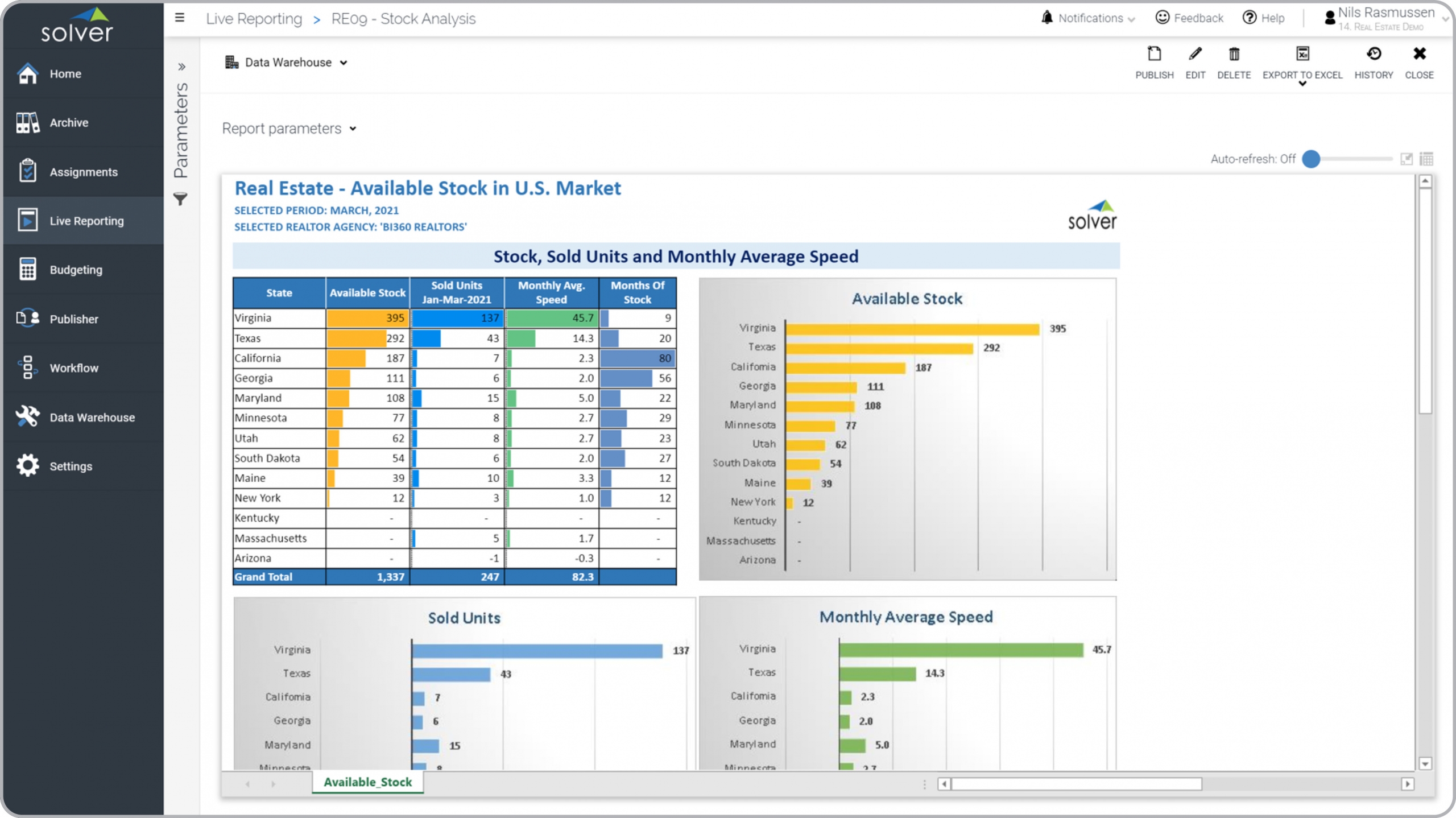Sales and Inventory Dashboard for Real Estate Companies
What is a
Sales and Inventory Dashboard
? Sales and Inventory Dashboards are considered analysis tools and are often used by executives and sales leaders to track and compare sales and available stock of properties across regions. Some of the main functionality in this type of dashboard is that it provides four analytical perspectives with real estate KPIs, including: 1) Monthly metrics by state with measures for: Available stock (inventory), Sold units year-to-date (YTD), monthly average sales velocity (speed"), Months of inventory, 2) Available inventory ranked by state, 3) Sold units by state, and 4) Monthly average sales velocity ("speed") by state. You find an example of this type of dashboard below.
Purpose of Real Estate
Sales and Inventory Dashboards Real Estate companies use Sales and Inventory Dashboards to give managers a clear monthly picture of regional sales versus the available stock of properties. When used as part of good business practices in Sales and Financial Planning and Analysis (FP&A) departments, a company can improve its sales and marketing strategies, and it can reduce the chances that revenues are sub-optimized because of lack of real time insight to property inventory versus sales comparisons.
Example of a
Sales and Inventory Dashboard Here is an example of a Sales and Inventory Dashboard with regional comparisons and KPIs. [caption id="" align="alignnone" width="2560"]
 Example of a Sales and Inventory Dashboard for Real Estate Companies[/caption] You can find hundreds of additional examples
here
Who Uses This Type of
Dashboard
? The typical users of this type of dashboard are: Sales Executives, CFOs, budget managers and executives.
Other Reports Often Used in Conjunction with
Sales and Inventory Dashboards Progressive Sales and Financial Planning and Analysis (FP&A) departments sometimes use several different Sales and Inventory Dashboards, along with sales reports, property inventory reports, KPI dashboards, financial statements, annual budget models, sales forecasts and other management and control tools.
Where Does the Data for Analysis Originate From? The Actual (historical transactions) data typically comes from enterprise resource planning (ERP) systems like: Microsoft Dynamics 365 (D365) Finance, Microsoft Dynamics 365 Business Central (D365 BC), Microsoft Dynamics AX, Microsoft Dynamics NAV, Microsoft Dynamics GP, Microsoft Dynamics SL, Sage Intacct, Sage 100, Sage 300, Sage 500, Sage X3, SAP Business One, SAP ByDesign, Acumatica, Netsuite and others. In analyses where budgets or forecasts are used, the planning data most often originates from in-house Excel spreadsheet models or from professional corporate performance management (CPM/EPM) solutions.
What Tools are Typically used for Reporting, Planning and Dashboards? Examples of business software used with the data and ERPs mentioned above are:
Example of a Sales and Inventory Dashboard for Real Estate Companies[/caption] You can find hundreds of additional examples
here
Who Uses This Type of
Dashboard
? The typical users of this type of dashboard are: Sales Executives, CFOs, budget managers and executives.
Other Reports Often Used in Conjunction with
Sales and Inventory Dashboards Progressive Sales and Financial Planning and Analysis (FP&A) departments sometimes use several different Sales and Inventory Dashboards, along with sales reports, property inventory reports, KPI dashboards, financial statements, annual budget models, sales forecasts and other management and control tools.
Where Does the Data for Analysis Originate From? The Actual (historical transactions) data typically comes from enterprise resource planning (ERP) systems like: Microsoft Dynamics 365 (D365) Finance, Microsoft Dynamics 365 Business Central (D365 BC), Microsoft Dynamics AX, Microsoft Dynamics NAV, Microsoft Dynamics GP, Microsoft Dynamics SL, Sage Intacct, Sage 100, Sage 300, Sage 500, Sage X3, SAP Business One, SAP ByDesign, Acumatica, Netsuite and others. In analyses where budgets or forecasts are used, the planning data most often originates from in-house Excel spreadsheet models or from professional corporate performance management (CPM/EPM) solutions.
What Tools are Typically used for Reporting, Planning and Dashboards? Examples of business software used with the data and ERPs mentioned above are:
- Native ERP report writers and query tools
- Spreadsheets (for example Microsoft Excel)
- Corporate Performance Management (CPM) tools (for example Solver)
- Dashboards (for example Microsoft Power BI and Tableau)
Corporate Performance Management (CPM) Cloud Solutions and More Examples
July 3, 2021
TAGS:
Reporting,
Solver,
report writer,
Microsoft,
template,
practice,
Acumatica,
Netsuite,
Finance,
planning,
GP,
dashboard,
Inventory,
Business Central,
state,
excel,
ax,
forecast,
Budget,
Dynamics 365,
budgeting,
region,
Cloud,
Software,
Tableau,
SAP,
example,
best,
Sage,
BC,
D365,
NAV,
Intacct,
Real Estate,
CPM,
report,
SL,
Management,
dynamics,
sales,
Power BI,
property,
available stock,
available inventory

